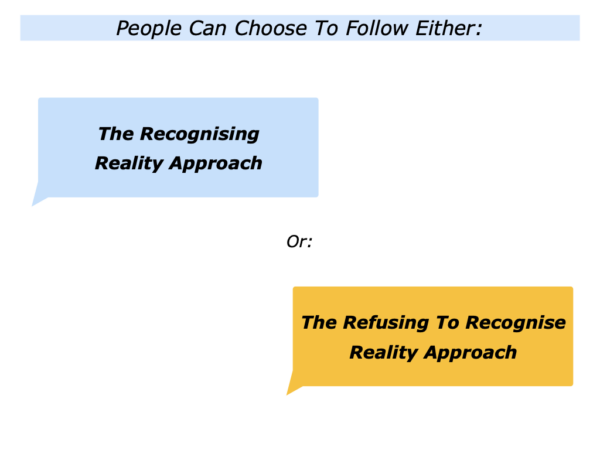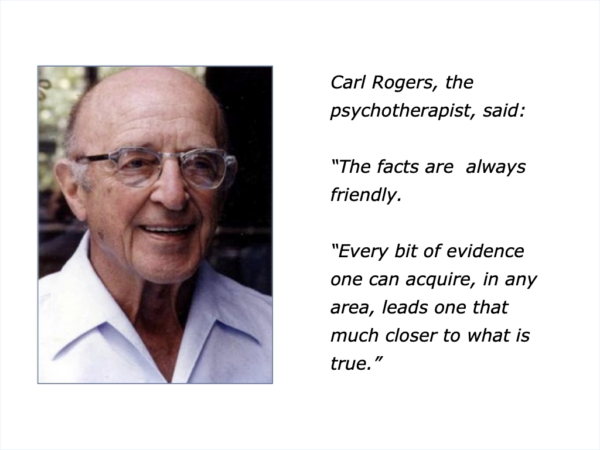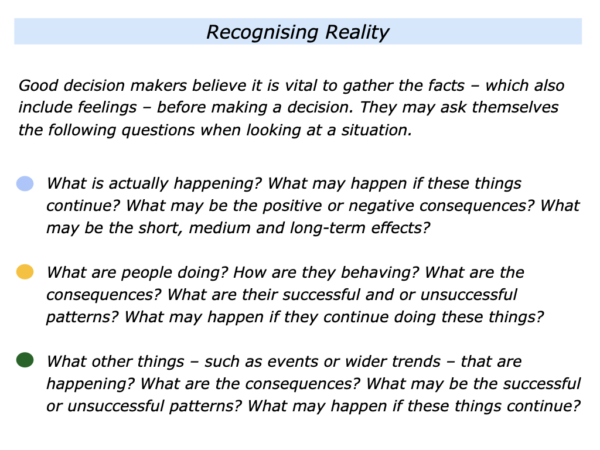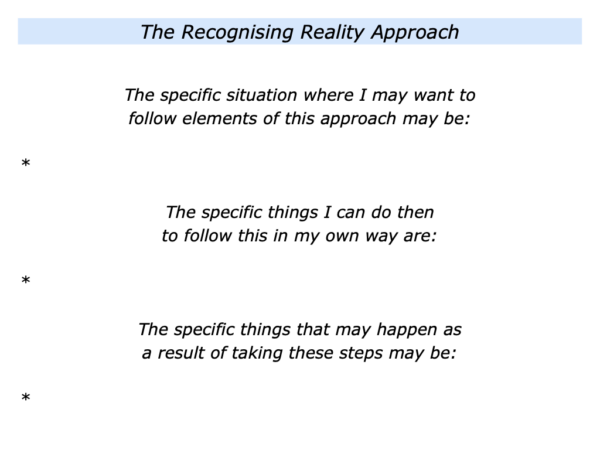
There are many ways to live life and make decisions. Some people follow the recognising reality approach. Some follow the refusing to recognise reality approach.
Different people follow these routes for different reasons. The route they choose to follow has consequences for both themselves and other people. Let’s explore these different approaches.
The Recognising
Reality Approach
Good decision makers believe in gathering lots of information about a situation before exploring all the possible ways forward. They often take the following steps.
They recognise the reality of the situation. This includes clarifying what is actually happening – such as how people are behaving and the other events that are happening – and the potential consequences.
They focus on the real results to achieve. Bearing in mind what they can control in the situation, this involves focusing on the short, medium and long-term goals.
They explore the possible options going forwards together with the pluses and minuses of each option. They then pursue their chosen route and do their best to achieve the desired results.
Good decision makers recognise it is vital to base their decisions on reality. Many subscribe to the following approach.
The Facts Are Friendly Approach

Carl Rogers believed that people grew by facing reality. We should welcome information, he said, even if the new evidence shows that our previous views were mistaken.
Whatever the revelation, the facts are friendly. Let’s explore how you might employ this approach in your life and work.
You can gather information by
recognising the facts are friendly
Gather information with an open mind, we are told, even though this might challenge our present views. This is vital in order to make informed decisions.
Looking back on your life, can you think of a difficult situation where you adopted the approach that the facts were friendly? You may have lost a client, been concerned about an illness or faced another challenge.
Whatever the situation, you wanted to know the truth. How did you keep an open mind, even though you might have been going through difficulties? How did you gather the data? How did you then use the information to move forward?
Good decision makers believe it is vital to gather the facts – which also including feelings – before making a decision. Bearing this in mind, they may ask themselves the following questions.

Good leaders, for example, then follow their chosen model for exploring the possible ways forward. Some use the Three C approach. This involves focusing on clarity, creativity and concrete results.
Clarity
What are the things we can control in the situation? Bearing these in mind, what are the real results we want to achieve? What is the picture of success? What will be the benefits of achieving these aims? What will be happening that will show we have achieved the picture of success?
Creativity
What are the choices – the possible options – we have for trying to achieve the goals? What may be the consequences – the potential pluses and minuses – of each option? Are there any other potential creative solutions?
Concrete Results
What is the route – or combination of routes – we want to follow? What are the strategies we can follow to give ourselves the greatest chance of success? How can we translate these into action? What else can we do to increase the chance of achieving success?
Such people often make decisions on the consequences of the options rather than the options themselves. They then aim to build on the pluses and minimise the minuses.
Good decision makers believe it is vital to base their decisions on reality. Some people take another different approach. Let’s explore this theme.
The Refusing To
Recognise Reality Approach
Some people refuse to recognise reality. Different people do this for different reasons. Here are some of the reasons why they may take this approach.
They may prefer to be in denial. They may do this because taking this approach provides short-term comfort. They can get on with their lives without taking what may be challenging decisions.
They may have an investment in refusing to face reality. They have an emotional, economic or other investment that means they prefer to continue behaving in the same way.
They may have a paradigm – a belief system or way of looking at the world – that means they only see what supports their present position. This highlights a key issue:
Do we believe what we see or do we see what we believe?
As we know, this is called confirmation bias. This can be reassuring for them, but sometimes it means they refuse to read reality. Such an approach can be dangerous for them and also for other people.
Some people may refuse to recognise reality because they are afraid of the consequences. They may not know how to manage the potential challenges. They therefore prefer to deny reality.
There are many ways to make decisions. One approach is to recognise reality. This can sometimes be challenging but it can provide the platform for shaping a positive future.
Looking ahead, can you think of a situation where you may want to follow elements of this approach? How can you do this in your own way? What may happen as a result of taking these steps?
If you wish, try tackling the exercise on this theme. This invites you to complete the following sentences.



Leave a Reply